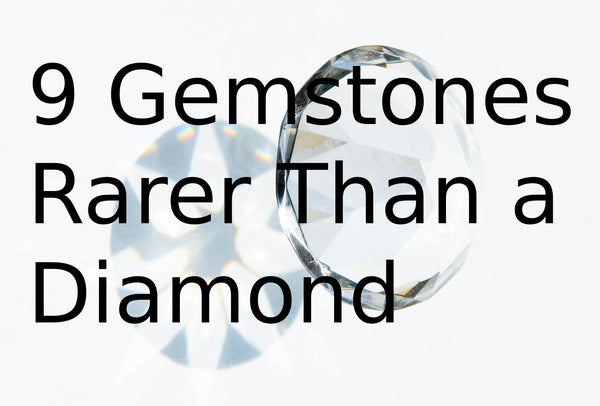MOTHER'S DAY SALE! Up To 50% OFF & 15% OFF Code: MOM15 + Free Shipping |Track My Order
9 Gemstones Rarer Than A Diamond

Diamonds may be forever, but the world of gemstones holds treasures far beyond the classic sparkle of these precious stones. While diamonds have long been the symbol of luxury and endurance, there exist gemstones that are rarer, more vibrant, and often imbued with fascinating histories and cultural significance. In this article, we delve into nine such gemstones that outshine diamonds in rarity and allure.
1.) Painite
The Guinness Book of World Records claimed that in 2005, painite was the rarest gemstone in the world, even rarer than diamonds. The color can vary anywhere from pink to reddish, and even brown in color, but can even appear green under certain lighting. Originally named after the gemologist that discovered it during the 1950's Arthur Charles Davy Pain, painite can be found in Myanmar and Magok. There are less than 25 gemstones now, while there are a couple of thousand fragmented pieces of the stone.

2.) Taaffeite
Found to be a million times more rare than the diamond, the taaffeite stone, which can be anywhere from clear-mauve to purple-red, was named after the gemologist that originally discovered it in 1945, Richard Taaffe. They were in a box of gemstones from Sri Lanka that were primarily single refraction stones, while the taaffeite stone had double refraction. The only taaffeite stones on earth would only fill about a ½ measuring cup. Because they are so rare, they can sell for up to $4,000 per carat. There are only about 10 taaffeite stones on earth that have the red coloring.

3.) Red Beryl
The red beryl, or bixbite, is thought of as a "red emerald" because it is very similar to the chemical makeup of the beautiful green stone. Although it looks similar to a ruby, there are about 8,000 times more rubies on earth than red beryl stones. First discovered in the early 1900's, the red beryl is mostly mined in New Mexico and Utah in the United States. It has been known to sell for up to $10,000 per carat.

4.) Alexandrite
Belonging to the same family as the emerald, the alexandrite is a chrysoberyl. It can change color according to the source of light and by the angle at which you view it. The combination of chromium, titanium and iron within the stone are what makes it have such rare color-changing abilities. When viewed in softer incandescent light sources, the stone is red-purple. When viewed in the sun, it appears to be green-blue. This wondrous gem can be found in Sri Lanka, Burma, Madagascar, Brazil, India, Tanzania, Zimbabwe, and largely found in Russia.

5.) Jadeite
In the late 1990's, a jadeite necklace was sold in Christie's auction house for almost $10 million. Jadeite is a stone that is found in small quantities when it is mined. The most valuable jadeite stones are the ones that appear to be a translucent green in color, but each stone can vary in its translucency. It is a stone that was used as far back as the Stone Age as tools. Jadeite can be found in parts of New Zealand, Japan, Russia, Canada, Turkestan, Italy, Kazakhstan, Guatemala, Myanmar and in the United States, more specifically California.

6.) Grandidierite
Primarily mined in Madagascar, one of the first grandidierite gemstones mined was found in Sri Lanka. It is a pleochroic gemstone and can appear blue, green or white, depending on the light in which it is viewed. The stone was named after Alfred Grandidier, a French natural historian.

7.) Benitoite
Originally found in the early 1900's, the blueish-purplish benitoite is primarily found in San Benito County, California near the San Benito River. When viewed under a UV light, the benitoite portrays magnificently brilliant color that almost glows. It is not clear what chemical properties give it such an unusual color. The benitoite can sell for up to $2,000 per carat.

8.) Poudretteite
Not found until the 1960's, the poudretteite gemstone was mined in the Poudrette quarry Quebec, but wasn't officially named a mineral until the 1980's. A 3 carat poudretteite was found in Magok, Myanmar in 2000. The gemstone itself is much too soft to be worn in a ring, but would work best as earrings or a pendant. It is not surprising that most people will never have even heard of the unusual gemstone, much less ever see one in person.

9.) Tanzanite
It is likely that there will be no more tanzanite to be mined in the next couple of decades. Found in the hills of Mount Kilimanjaro in the north part of Tanzania, this purple stone can have a shift in color depending on the lighting and on the crystal makeup of the stone itself. This is because of the vanadium ions within the stone. The stone will appear different colors in unpolarized light, vertically polarized light and horizontally polarized light.

